
NCERT Solutions for Class 6 Maths Chapter 7
NCERT Solutions for Class 6 Maths Chapter 7: Experts at PW have crafted the NCERT Solutions for Class 6 Maths Chapter 7 Fractions according to the latest CBSE Syllabus for Class 6. This enables students to practice effectively for their final exams. A fraction is a numerical representation of a part of a whole, which can be a single object or a group of objects with equal parts. A fraction is considered in its simplest form when its numerator and denominator have no common factor except 1. Engaging with NCERT Solutions is designed to boost students' confidence in solving fraction-related problems.NCERT Solutions for Class 6 Maths Chapter 7 Overview
The CBSE Maths syllabus for Class 6 focuses on fundamental aspects of Fractions, allowing students to explore interesting concepts. Various methods in NCERT Maths Class 6 Chapter 7 Fractions aid students in learning quick-solving techniques to save time during exams. NCERT Solutions for Class 6 Maths Chapter 7 feature distinct question-and-answer sets, detailed explanations, diagrams, etc., helping students prepare for their final exams and reinforcing fundamental concepts. Every NCERT Solution is presented to simplify and make studying interesting on PhysicsWallah. You can access the NCERT Solution for Class 6 Science to achieve better scores in examinations.NCERT Solutions for Class 6 Maths Chapter 7 Fractions
Chapter 7 of 6th-grade Mathematics might seem a bit challenging for students as it covers various topics related to different kinds of Fractions. To excel in this chapter, students should concentrate on understanding the basics. There are many options to find suitable study materials that can assist in exploring the key concepts of this chapter. The worksheet with answers for NCERT Solutions Class 6 Maths Chapter 7 not only helps in understanding crucial aspects of Fractions but also aids in tackling tricky questions. While some parts of this chapter may appear difficult initially, once a student comprehends them thoroughly, these questions become less daunting. You can find the PDF of NCERT Solutions for Class 6 Maths Chapter 7 on our website, providing the right approach to achieve high scores in Mathematics. Exercise 7.1 Page No: 135 1. Write the fraction representing the shaded portion.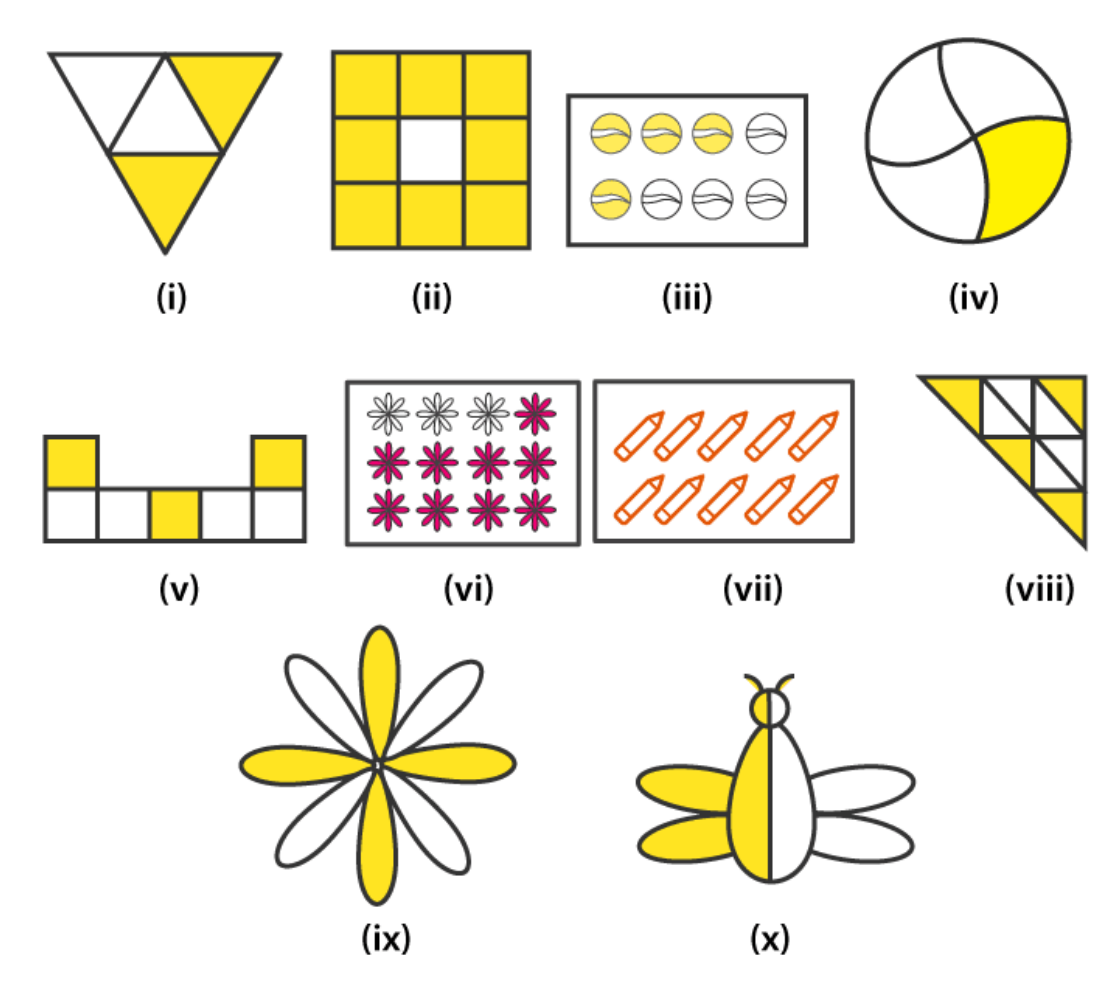 Solutions:
(i)
Number of parts = 4
Shaded portion = 2
∴ Fraction = 2 / 4
(ii)
Number of parts = 9
Shaded portion = 8
∴ Fraction = 8 / 9
(iii)
Number of parts = 8
Shaded portion = 4
∴ Fraction = 4 / 8
(iv)
Number of parts = 4
Shaded portion = 1
∴ Fraction = 1 / 4
(v)
Number of parts = 7
Shaded portion = 3
∴ Fraction = 3 / 7
Solutions:
(i)
Number of parts = 4
Shaded portion = 2
∴ Fraction = 2 / 4
(ii)
Number of parts = 9
Shaded portion = 8
∴ Fraction = 8 / 9
(iii)
Number of parts = 8
Shaded portion = 4
∴ Fraction = 4 / 8
(iv)
Number of parts = 4
Shaded portion = 1
∴ Fraction = 1 / 4
(v)
Number of parts = 7
Shaded portion = 3
∴ Fraction = 3 / 7
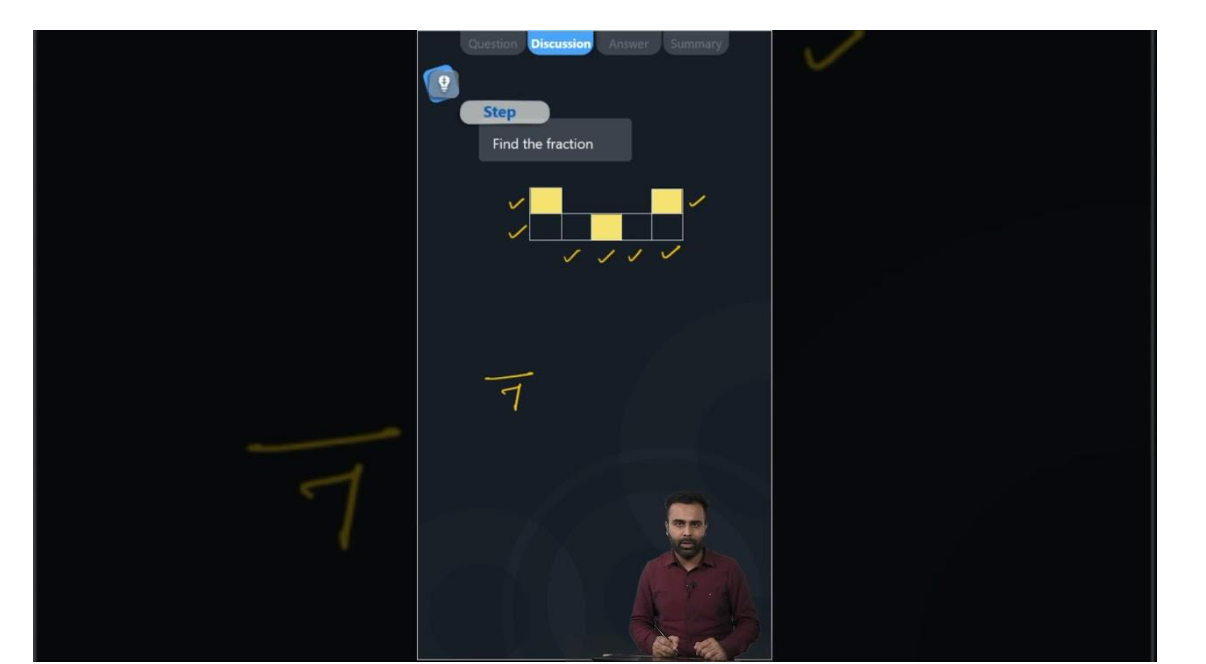 145
(vi)
Number of parts = 12
Shaded portion = 3
∴ Fraction = 3 / 12
(vii)
Number of parts = 10
Shaded portion = 10
∴ Fraction = 10 / 10
(viii)
Number of parts = 9
Shaded portion = 4
∴ Fraction = 4 / 9
(ix)
Number of parts = 8
Shaded portion = 4
∴ Fraction = 4 / 8
(x)
Number of parts = 2
Shaded portion = 1
∴ Fraction = 1 / 2
2. Colour the part according to the given fraction.
145
(vi)
Number of parts = 12
Shaded portion = 3
∴ Fraction = 3 / 12
(vii)
Number of parts = 10
Shaded portion = 10
∴ Fraction = 10 / 10
(viii)
Number of parts = 9
Shaded portion = 4
∴ Fraction = 4 / 9
(ix)
Number of parts = 8
Shaded portion = 4
∴ Fraction = 4 / 8
(x)
Number of parts = 2
Shaded portion = 1
∴ Fraction = 1 / 2
2. Colour the part according to the given fraction.
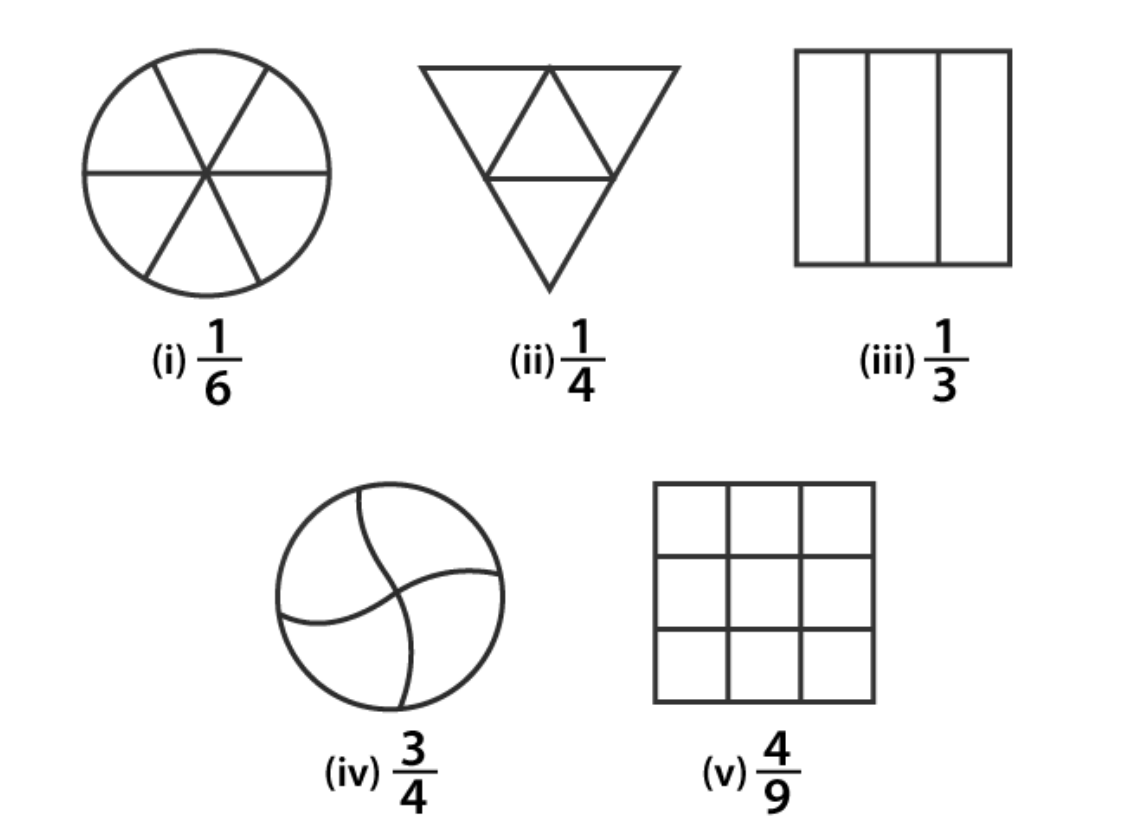 Solutions:
Solutions:
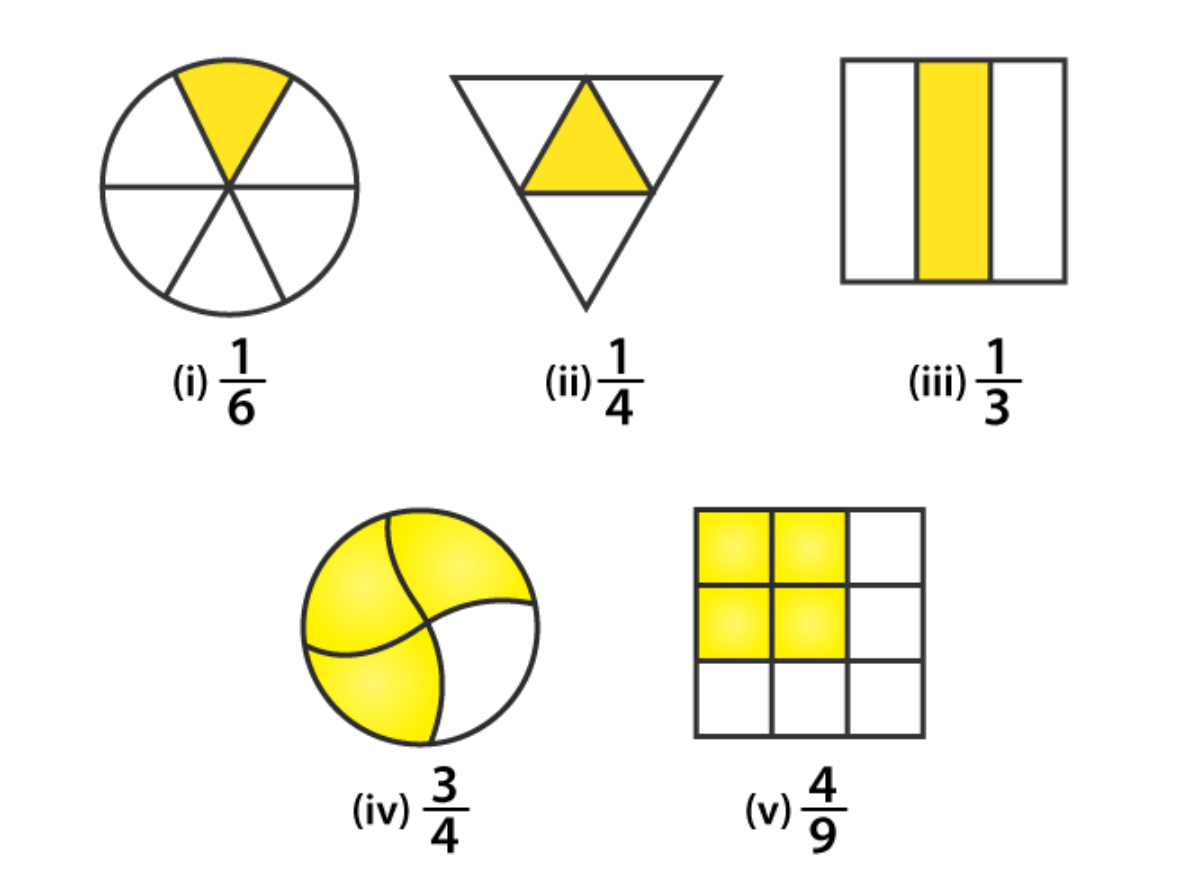 3. Identify the error, if any.
3. Identify the error, if any.
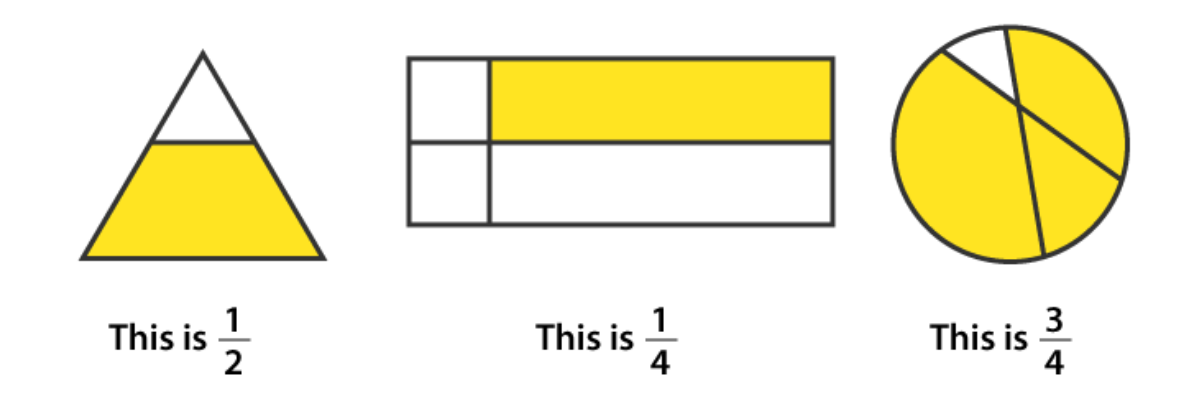 Solutions:
(i)
The shaded portion is not half
Hence, this is not 1 / 2
(ii)
Since the parts are not equal
∴ Shaded portion is not 1 / 4
(iii)
Since the parts are not equal
∴ Shaded portion is not 3 / 4
4. What fraction of a day is 8 hours?
Solutions:
There are 24 hours in a day
We have 8 hours
Hence, required fraction is 8 / 24
5. What fraction of an hour is 40 minutes?
Solutions:
There are 60 minutes in 1 hour
∴ 1 hour = 60 minutes
Hence, required Fraction = 40 / 60
Solutions:
(i)
The shaded portion is not half
Hence, this is not 1 / 2
(ii)
Since the parts are not equal
∴ Shaded portion is not 1 / 4
(iii)
Since the parts are not equal
∴ Shaded portion is not 3 / 4
4. What fraction of a day is 8 hours?
Solutions:
There are 24 hours in a day
We have 8 hours
Hence, required fraction is 8 / 24
5. What fraction of an hour is 40 minutes?
Solutions:
There are 60 minutes in 1 hour
∴ 1 hour = 60 minutes
Hence, required Fraction = 40 / 60
6. Arya, Abhimanyu, and Vivek shared lunch. Arya has brought two sandwiches, one made of vegetable and one of jam. The other two boys forgot to bring their lunch. Arya agreed to share his sandwiches so that each person will have an equal share of each sandwich.
(a) How can Arya divide his sandwiches so that each person has an equal share? (b) What part of a sandwich will each boy receive? Solutions: (a) Arya has divided the sandwich into 3 equal parts. So each person will get one part. (b) Each boy receive 1 / 3 part ∴ Required Fraction is 1 / 3 7. Kanchan dyes dresses. She had to dye 30 dresses. She has so far finished 20 dresses. What fraction of dresses has she finished? Solutions: Total number of dresses Kanchan has to dye = 30 dresses Number of dresses she has finished = 20 dresses ∴ Required Fraction = 20 / 30 = 2 / 3 8. Write the natural numbers from 2 to 12. What fraction of them are prime numbers? Solutions: Natural numbers from 2 to 12 are 2, 3, 4, 5, 6, 7, 8, 9, 10, 11, 12 Total number of natural numbers given= 11 Number of prime numbers = 5 ∴ Required Fraction = 5 / 11 9. Write the natural numbers from 102 to 113. What fraction of them are prime numbers? Solutions: Natural numbers from 102 to 113 are 102, 103, 104, 105, 106, 107, 108, 109, 110, 111, 112, 113 Total number of natural numbers given = 12 Number of prime numbers = 4 [103, 107, 109, 113] ∴ Required Fraction = 4 / 12 = 1 / 3 10. What fraction of these circles have Xs in them?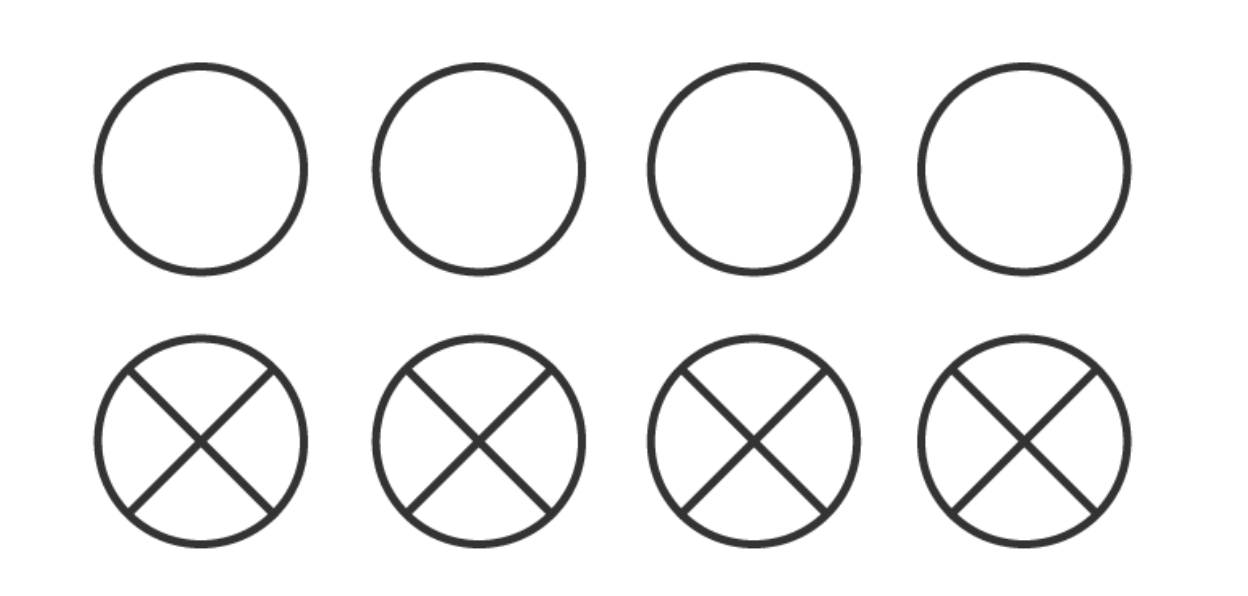 Solutions:
Total number of circles in the figure = 8
Number of circles having Xs in them = 4
∴ Required Fraction = 4 / 8 = 1 / 2
11. Kristin received a CD player for her birthday. She bought 3 CDs and received 5 others as gifts. What fraction of her total CDs did she buy and what fraction did she receive as gifts?
Solutions:
Number of CDs Kristin bought from the market = 3
Number of CDs received as gifts = 5
Total number of CDs Kristin have = 3 + 5 = 8
∴ Fraction of CD she bought = 3 / 8
∴ Fraction of CDs received as gifts = 5 / 8
Exercise 7.2 Page No: 141
1. Draw number lines and locate the points on them:
(a) 1 / 2, 1 / 4, 3 / 4, 4 / 4
(b) 1 / 8, 2 / 8, 3 / 8, 7 / 8
(c) 2 / 5, 3 / 5, 8 / 5, 4 / 5
Solutions:
(a)
1 / 2, 1 / 4, 3 / 4, 4 / 4
Solutions:
Total number of circles in the figure = 8
Number of circles having Xs in them = 4
∴ Required Fraction = 4 / 8 = 1 / 2
11. Kristin received a CD player for her birthday. She bought 3 CDs and received 5 others as gifts. What fraction of her total CDs did she buy and what fraction did she receive as gifts?
Solutions:
Number of CDs Kristin bought from the market = 3
Number of CDs received as gifts = 5
Total number of CDs Kristin have = 3 + 5 = 8
∴ Fraction of CD she bought = 3 / 8
∴ Fraction of CDs received as gifts = 5 / 8
Exercise 7.2 Page No: 141
1. Draw number lines and locate the points on them:
(a) 1 / 2, 1 / 4, 3 / 4, 4 / 4
(b) 1 / 8, 2 / 8, 3 / 8, 7 / 8
(c) 2 / 5, 3 / 5, 8 / 5, 4 / 5
Solutions:
(a)
1 / 2, 1 / 4, 3 / 4, 4 / 4
 Here divide the number line from 0 to 1 into four equal parts
C = 2 / 4 = 1 / 2
B = 1 / 4
D = 3 / 4 and
E = 4 / 4 = 1
(b)
1 / 8, 2 / 8, 3 / 8, 7 / 8
Here divide the number line from 0 to 1 into four equal parts
C = 2 / 4 = 1 / 2
B = 1 / 4
D = 3 / 4 and
E = 4 / 4 = 1
(b)
1 / 8, 2 / 8, 3 / 8, 7 / 8
 Divide the number line from 0 to 1 into eight equal parts
B = 1 / 8
C = 2 / 8
D = 3 / 8
H = 7 / 8
(c)
2 / 5, 3 / 5, 8 / 5, 4 / 5
Divide the number line from 0 to 1 into eight equal parts
B = 1 / 8
C = 2 / 8
D = 3 / 8
H = 7 / 8
(c)
2 / 5, 3 / 5, 8 / 5, 4 / 5
 From the given number line, we have
C = 2 / 5
D = 3 / 5
E = 4 / 5
I = 8 / 5
From the given number line, we have
C = 2 / 5
D = 3 / 5
E = 4 / 5
I = 8 / 5
2. Express the following as mixed fractions:
(a) 20 / 3 (b) 11 / 5 (c) 17 / 7 (d) 28 / 5 (e) 19 / 6 (f) 35 / 9 Solutions: (a) 20 / 3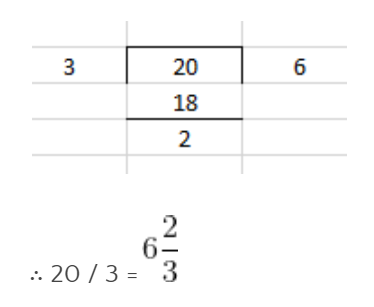 (b)
11 / 5
(b)
11 / 5
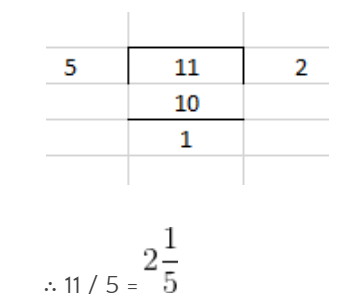 (c)
17 / 7
(c)
17 / 7
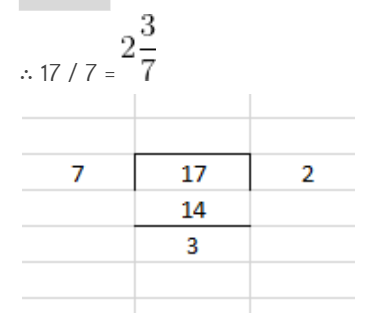 (d)
28 / 5
(d)
28 / 5
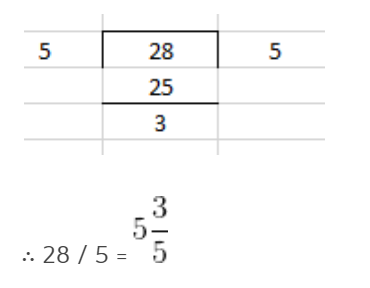 (e)
19 / 6
(e)
19 / 6
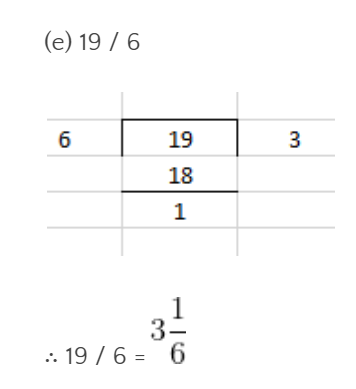 (f)
35 / 9
(f)
35 / 9

3. Express the following as improper fractions:
(a) (b) (c) (d) (e) (f) Solutions: (a) (7 × 4 + 3) / 4 = 31 / 4 ∴ The improper form is 31 / 4 (b) (5 × 7 + 6) / 7 = 41 / 7 ∴ The improper form is 41 / 7 (c) (2 × 6 + 5) / 6 = 17 / 6 ∴ The improper form is 17 / 6 (d) (10 × 5 + 3) / 5 = 53 / 5 ∴ The improper form is 53 / 5 (e) (9 × 7 + 3) / 7 = 66 / 7 ∴ The improper form is 66 / 7 (f) (8 × 9 + 4) / 9 = 76 / 9 ∴ The improper form is 76 / 9CBSE Board Exam Centre List 2024
Exercise 7.3 Page No: 146 1. Write the fractions. Are all these fractions equivalent?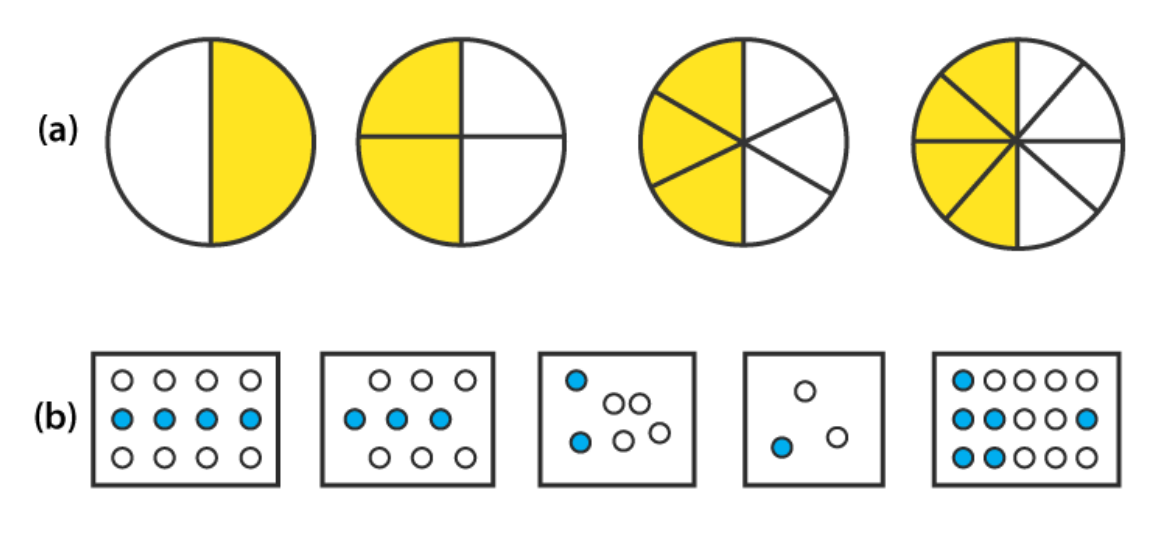 Solutions:
(a)
(i)
The shaded portion is 1 / 2
(ii)
The shaded portion is 2 / 4 = (2 / 2) / (4 / 2) = 1 / 2
(iii)
The shaded portion is 3 / 6 = (3 / 3) / (6 / 3) = 1 / 2
(iv)
The shaded portion is 4 / 8 = (4 / 4) / (8 / 4) = 1 / 2
Hence, all fractions are equivalent.
Solutions:
(a)
(i)
The shaded portion is 1 / 2
(ii)
The shaded portion is 2 / 4 = (2 / 2) / (4 / 2) = 1 / 2
(iii)
The shaded portion is 3 / 6 = (3 / 3) / (6 / 3) = 1 / 2
(iv)
The shaded portion is 4 / 8 = (4 / 4) / (8 / 4) = 1 / 2
Hence, all fractions are equivalent.
(b)
(i) The shaded portion is 4 / 12 = (4 / 4) / (12 / 4) = 1 / 3 (ii) The shaded portion is 3 / 9 = (3 / 3) / (9 / 3) = 1 / 3 (iii) The shaded portion is 2 / 6 = (2 / 2) / (6 / 2) = 1 / 3 (iv) The shaded portion is 1 / 3 (v) The shaded portion is 6 / 15 = (6 / 3) / (15 / 3) = 2 / 5 All the fractions in their simplest form are not equal Hence, they are not equivalent fractions. 2. Write the fractions and pair up the equivalent fractions from each row.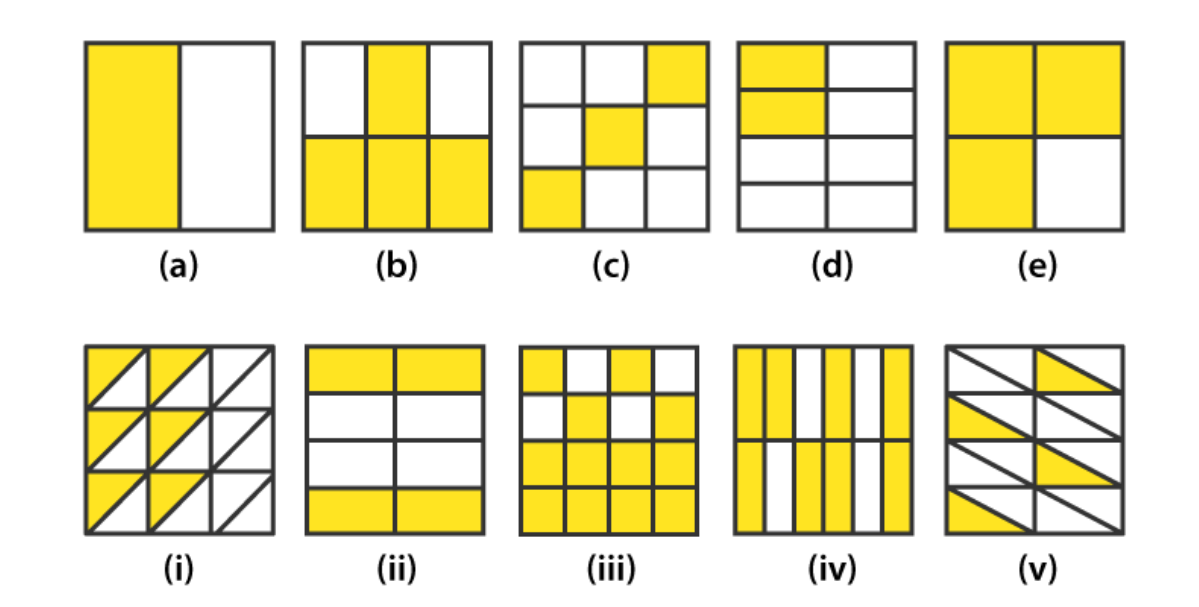 Solutions:
(a)
1 / 2
(b)
4 / 6 = (4 / 2) / (6 / 2)
= 2 / 3
(c)
3 / 9 = (3 / 3) / (9 / 3)
= 1 / 3
(d)
2 / 8 = (2 / 2) / (8 / 2)
= 1 / 4
(e)
3 / 4
(i)
6 / 18 = (6 / 6) / (18 / 6)
= 1 / 3
(ii)
4 / 8 = (4 / 4) / (8 / 4)
= 1 / 2
(iii)
12 / 16 = (12 / 4) / (16 / 4)
= 3 / 4
(iv)
8 / 12 = (8 / 4) / (12 / 4)
= 2 / 3
(v)
4 / 16 = (4 / 4) / (16 / 4)
= 1 / 4
The following are the equivalent fractions
(a) and (ii) = 1 / 2
(b) and (iv) = 2 / 3
(c) and (i) = 1 / 3
(d) and (v) = 1 / 4
(e) and (iii) = 3 / 4
3. Replace
☐
in each of the following by the correct number:
(a) 2 / 7 = 8 /
☐
(b) 5 / 8 = 10 / ☐
(c) 3 / 5 = ☐ / 20
(d) 45 / 60 = 15 / ☐
(e) 18 / 24 = ☐ / 4
Solutions:
(a)
Given
2 / 7 = 8
/
☐
2 × ☐ = 7 × 8
☐ = (7 × 8) / 2
= 28
(b)
Given
5 / 8 = 10 / ☐
☐ = (8 × 10) / 5
= 16
(c)
Given
3 / 5 = ☐ / 20
☐ = (3 × 20) / 5
= 12
(d)
Given
45 / 60 = 15 / ☐
☐ = (15 × 60) / 45
= 20
(e)
Given
18 / 24 = ☐ / 4
☐ = (18 × 4) / 24
= 3
4. Find the equivalent fraction of 3 / 5 having
(a) denominator 20
(b) numerator 9
(c) denominator 30
(d) numerator 27
Solutions:
(a)
We require denominator 20
Let M be the numerator of the fractions
∴ M / 20 = 3 / 5
5 × M = 20 × 3
M = (20 × 3) / 5
= 12
Therefore, the required fraction is 12 / 20
(b)
We require numerator 9
Let N be the denominator of the fractions
∴ 9 / N = 3 / 5
3 × N = 9 × 5
N = (9 × 5) / 3
= 15
Therefore, the required fraction is 9 / 15
(c)
We require denominator 30
Let D be the numerator of the fraction
∴ D / 30 = 3 / 5
5 × D = 3 × 30
D = (3 × 30) / 5
= 18
Therefore, the required fraction is 18 / 30
(d)
We require numerator 27
Let N be the denominator of the fraction
∴ 27 / N = 3 / 5
3 × N = 5 × 27
N = (5 × 27) / 3
= 45
Therefore, the required fraction is 27 / 45
Solutions:
(a)
1 / 2
(b)
4 / 6 = (4 / 2) / (6 / 2)
= 2 / 3
(c)
3 / 9 = (3 / 3) / (9 / 3)
= 1 / 3
(d)
2 / 8 = (2 / 2) / (8 / 2)
= 1 / 4
(e)
3 / 4
(i)
6 / 18 = (6 / 6) / (18 / 6)
= 1 / 3
(ii)
4 / 8 = (4 / 4) / (8 / 4)
= 1 / 2
(iii)
12 / 16 = (12 / 4) / (16 / 4)
= 3 / 4
(iv)
8 / 12 = (8 / 4) / (12 / 4)
= 2 / 3
(v)
4 / 16 = (4 / 4) / (16 / 4)
= 1 / 4
The following are the equivalent fractions
(a) and (ii) = 1 / 2
(b) and (iv) = 2 / 3
(c) and (i) = 1 / 3
(d) and (v) = 1 / 4
(e) and (iii) = 3 / 4
3. Replace
☐
in each of the following by the correct number:
(a) 2 / 7 = 8 /
☐
(b) 5 / 8 = 10 / ☐
(c) 3 / 5 = ☐ / 20
(d) 45 / 60 = 15 / ☐
(e) 18 / 24 = ☐ / 4
Solutions:
(a)
Given
2 / 7 = 8
/
☐
2 × ☐ = 7 × 8
☐ = (7 × 8) / 2
= 28
(b)
Given
5 / 8 = 10 / ☐
☐ = (8 × 10) / 5
= 16
(c)
Given
3 / 5 = ☐ / 20
☐ = (3 × 20) / 5
= 12
(d)
Given
45 / 60 = 15 / ☐
☐ = (15 × 60) / 45
= 20
(e)
Given
18 / 24 = ☐ / 4
☐ = (18 × 4) / 24
= 3
4. Find the equivalent fraction of 3 / 5 having
(a) denominator 20
(b) numerator 9
(c) denominator 30
(d) numerator 27
Solutions:
(a)
We require denominator 20
Let M be the numerator of the fractions
∴ M / 20 = 3 / 5
5 × M = 20 × 3
M = (20 × 3) / 5
= 12
Therefore, the required fraction is 12 / 20
(b)
We require numerator 9
Let N be the denominator of the fractions
∴ 9 / N = 3 / 5
3 × N = 9 × 5
N = (9 × 5) / 3
= 15
Therefore, the required fraction is 9 / 15
(c)
We require denominator 30
Let D be the numerator of the fraction
∴ D / 30 = 3 / 5
5 × D = 3 × 30
D = (3 × 30) / 5
= 18
Therefore, the required fraction is 18 / 30
(d)
We require numerator 27
Let N be the denominator of the fraction
∴ 27 / N = 3 / 5
3 × N = 5 × 27
N = (5 × 27) / 3
= 45
Therefore, the required fraction is 27 / 45
| CBSE Syllabus Class 6 | |
| CBSE Class 6 Science Syllabus | CBSE Class 6 Maths Syllabus |
| CBSE Class 6 Social Science Syllabus | CBSE Class 6 English Syllabus |
| Related Links |
NCERT Solutions for Class 6 Maths Chapter 7 FAQs
How to easily solve Fraction for Class 6 questions?
Practice with visual aids like pie charts, and use common denominators for easier Fraction problem-solving in Class 6.
How do you define fractions for Class 6 Maths Chapter 7?
Fractions in Class 6 Maths Chapter 7 are parts of a whole; numerator represents parts taken, and denominator represents the total parts.
What are proper, improper, and mixed fractions?
Proper fractions have a smaller numerator than denominator, improper fractions have a larger numerator, and mixed fractions combine whole numbers with fractions.
How can I get the NCERT Solutions for Class 6 Maths Chapter 7 online?
Access NCERT Solutions for Class 6 Maths Chapter 7 online through official websites, educational platforms, or NCERT app.
How do you add fractions according to Chapter 7 of Class 6 Maths?
To add fractions in Class 6 Maths Chapter 7, find a common denominator, add numerators, and simplify the result if needed.
Talk to a counsellorHave doubts? Our support team will be happy to assist you!

Free Learning Resources
PW Books
Notes (Class 10-12)
PW Study Materials
Notes (Class 6-9)
Ncert Solutions
Govt Exams
Class 6th to 12th Online Courses
Govt Job Exams Courses
UPSC Coaching
Defence Exam Coaching
Gate Exam Coaching
Other Exams
Know about Physics Wallah
Physics Wallah is an Indian edtech platform that provides accessible & comprehensive learning experiences to students from Class 6th to postgraduate level. We also provide extensive NCERT solutions, sample paper, NEET, JEE Mains, BITSAT previous year papers & more such resources to students. Physics Wallah also caters to over 3.5 million registered students and over 78 lakh+ Youtube subscribers with 4.8 rating on its app.
We Stand Out because
We provide students with intensive courses with India’s qualified & experienced faculties & mentors. PW strives to make the learning experience comprehensive and accessible for students of all sections of society. We believe in empowering every single student who couldn't dream of a good career in engineering and medical field earlier.
Our Key Focus Areas
Physics Wallah's main focus is to make the learning experience as economical as possible for all students. With our affordable courses like Lakshya, Udaan and Arjuna and many others, we have been able to provide a platform for lakhs of aspirants. From providing Chemistry, Maths, Physics formula to giving e-books of eminent authors like RD Sharma, RS Aggarwal and Lakhmir Singh, PW focuses on every single student's need for preparation.
What Makes Us Different
Physics Wallah strives to develop a comprehensive pedagogical structure for students, where they get a state-of-the-art learning experience with study material and resources. Apart from catering students preparing for JEE Mains and NEET, PW also provides study material for each state board like Uttar Pradesh, Bihar, and others
Copyright © 2025 Physicswallah Limited All rights reserved.
Get App







